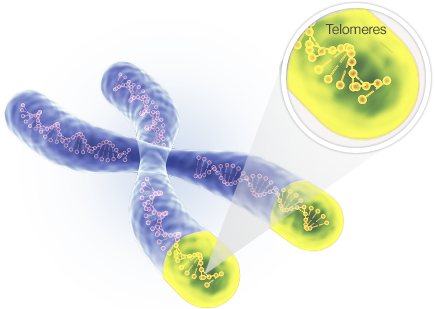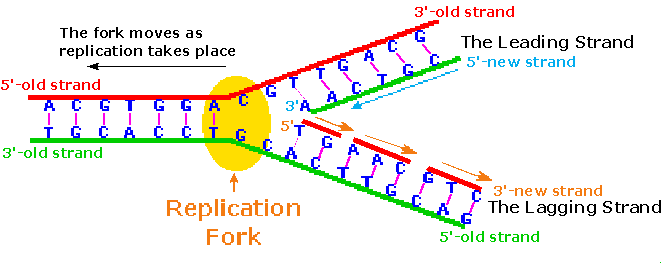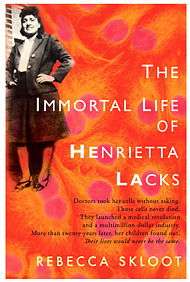Telomeres vs Telomerase
A telomere is a densely-packed region at the very end of chromosome (consisting of heterochromatin). Due to the high density of heterochromatin, these regions within chromosomes are rarely transcribed. The location of a telomere can be seen below.

Telomeres are necessary because of the problems that linear chromosomes pose to eukaryotic replication machinery. While leading strand synthesis (DNA replication in the same direction as the opening replication fork) can replicate the strand of DNA until the end of the chromosome, lagging strand (DNA replication in the reverse direction to the opening replication fork) synthesis will leave a short segment of DNA missing at the end of a chromosome, or an RNA-DNA duplex. The difference between leading and lagging strand synthesis can be seen below, and more information on DNA replication can be found here: https://www.khanacademy.org/science/biology/dna-as-the-genetic-material/dna-replication/a/molecular-mechanism-of-dna-replication.

If the un-replicated end of the lagging strand is left after each replication then there will be continual shortening of the chromosome and eventually some loss of genetic information. This is the reason that eukaryotes have telomeres at the end of their chromosomes. Telomeres are short sequences of bases, TTAGGG in humans, repeated about 1000 times to produce a protective cap for the chromosome end. This sequence is added by an enzyme called telomerase. Amazingly, telomerase is an enzyme that contains both a protein and an RNA component. The RNA component acts as a template for DNA synthesis (making telomerase a self-templating reverse transcriptase).
The action of the enzyme telomerase provides a solution to the lagging strand replication problem by adding these repeated sequences of DNA to the end of chromosomes. These chromosome ends can adopt alternative structures of DNA other than a B helix (see https://steemit.com/science/@ovij/what-is-dna-why-do-we-need-it for more detail). Such structures include a T-Loop and quadruplex DNA (which does not follow Watson-Crick base pairing).
Most normal adult cells have very low levels of telomerase. Every time that an adult cell divides its telomere gets shorter, since there is not enough telomerase to regenerate the telomeres again. Eventually the telomeres reach a critical length, which the cell reads and then terminates its cell division. This is called the Hayflick limit. Re-introduction of telomerase into these cells can keep them dividing and thus extend their lifespan. However, many cancer cell lines have elevated telomerase levels, which is thought to contribute to their immortality. Inhibitors of telomerase are being tested as possible anti-cancer drugs. Although activating telomerase could indeed make our cells divide forever, as the title of this article suggests, I feel this may not be as good as it initially appears. Constitutive activation of telomerase could be a fundamental idea in preventing ageing, but it may also be a very high contributor to tumour development and cancers.
HeLa cells
When discussing immortal cell lines, there is certainly one specific cell group that needs to be mentioned, HeLa cells. These were cells taken from the cancer of a women called Henrietta Lacks (hence the name HeLa) in 1951 without her consent (something that would not be condoned nowadays). It was discovered that HeLa cells were immortal, as they did not have a Hayflick limit. Part of this immortality is due to constitutive activation of telomerase. These HeLa cells were distributed around the world and cultured for research, still being used to this day, to date scientists have cultured around 20 tons of HeLa cells. HeLa cells are responsible for many scientific breakthroughs, yet the Lacks family have not benefitted from it. The ethics and story of HeLa cells is discussed in the book ‘The Immortal Life of Henrietta Lacks’ by Rebecca Skloot, which I would highly recommend.

Overall I feel that the benefits of our cells being able to constantly divide is not great enough to offset the possibility of accumulating many different cancer types.
References:
Image 1: http://www.viamedex.co.uk/telomere.php
Image 2: http://mydreamcats.blogspot.co.uk
https://en.wikipedia.org/wiki/HeLa
Activating telomarase causes cancer. Cells must die we don't need them to divide forever. We need new stem cells for source of new cells. Because if you activate telomerase and ok cells will divide forever but dont forget our chromosomes that must replicate and divide so continous division will increase chanse of activating oncogene.
Downvoting a post can decrease pending rewards and make it less visible. Common reasons:
Submit
I agree, that was the conclusion I came to at the end of the article.
Downvoting a post can decrease pending rewards and make it less visible. Common reasons:
Submit
very good friend
Downvoting a post can decrease pending rewards and make it less visible. Common reasons:
Submit
Upvoted by Emma
Downvoting a post can decrease pending rewards and make it less visible. Common reasons:
Submit
Thanks have been meaning to read up on this
Downvoting a post can decrease pending rewards and make it less visible. Common reasons:
Submit